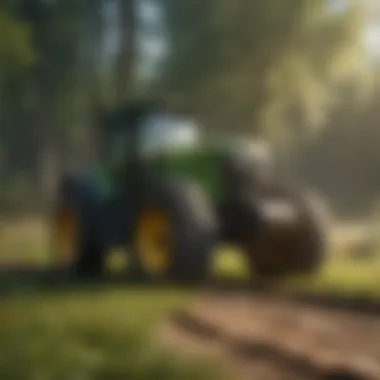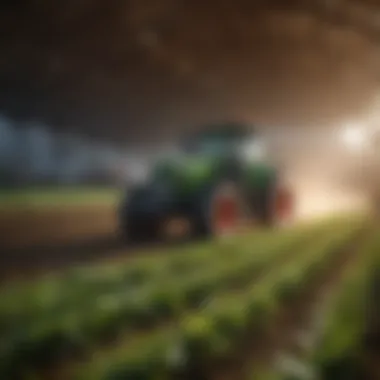Greencleaner: Innovations in Sustainable Agriculture


Overview of the Topic
Definition and Importance
Sustainable agriculture emphasizes producing food through methods that do not harm the environment. The concept of greencleaner aligns with this goal, focusing on cleaner farming practices that minimize chemical use and enhance biodiversity. Greencleaner represents a shift towards more responsible agricultural methods that consider ecological sustainability alongside productivity. The significance of this concept lies in its potential to reduce the carbon footprint, improve soil health, and promote a balanced ecosystem.
Current Trends
In recent years, there has been a noticeable shift in farming practices driven by technological advancements and a growing awareness of environmental issues. Innovations such as precision agriculture, organic farming, and regenerative practices are at the forefront. Farmers are increasingly adopting methods that integrate technology with sustainable practices. For example, drones and data analytics are now used to monitor crop health, allowing for targeted interventions that reduce input waste.
Key Techniques and Practices
Step-by-Step Guide
To adopt greencleaner practices, farmers can follow these steps:
- Assess Current Practices: Evaluate current farming techniques to identify areas for improvement.
- Research Sustainable Methods: Look into organic farming, agroforestry, and permaculture.
- Implement Changes Gradually: Start with one or two new practices to test their effectiveness before a full-scale adoption.
- Educate Staff and Community: Train workers on sustainable practices and involve the community in initiatives.
- Monitor and Adjust: Continuously monitor the results and adapt practices based on feedback and performance.
Tools and Equipment Needed
Implementing greencleaner techniques often requires specialized tools and equipment, including:
- Organic fertilizers
- Cover crop seeds
- Precision ag tools (like GPS and soil sensors)
- Drip irrigation systems
- Pest management tools that are environmentally friendly
Challenges and Solutions
Common Obstacles
Adopting greencleaner practices is not without challenges. Farmers may face:
- Resistance to change from traditional methods.
- Higher initial costs for sustainable inputs and equipment.
- A lack of information or resources on implementing new techniques.
Innovative Solutions
Solutions to these challenges can include:
- Developing education programs tailored to local communities and farmers.
- Accessing grants or subsidies to offset initial costs.
- Establishing cooperatives to share resources and knowledge among farmers.
"In embracing greencleaner practices, farmers not only benefit their operations but also contribute to a larger movement toward ecological responsibility."
By focusing on these aspects, the narrative of greencleaner evolves. It is not merely a trend but a necessity for the future of agriculture, promoting a harmonious balance between productivity and sustainability.
Prologue to Greencleaner
Sustainable agriculture is increasingly recognized as a focal point in discussions about food security and environmental preservation. Within this framework, Greencleaner emerges as a crucial concept and practice for modern agriculture. It embodies a commitment to cleaner, more responsible farming methods that harmonize productivity with ecological integrity. This section will elucidate the definition and historical context of Greencleaner, demonstrating its significance and relevance in today's agricultural landscape.
Definition and Concept
Greencleaner refers to the approach and practices in agriculture that prioritize environmental stewardship, efficiency, and sustainability. At its core, it advocates for methods that reduce the ecological footprint of farming. This includes using organic fertilizers and pest control, practicing crop rotation, and implementing minimal tillage. The objective is to optimize resource use while safeguarding ecosystems.
The term encapsulates a blend of traditional understanding and innovative practices. Greencleaner methodologies encourage farmers to embrace regenerative techniques that restore soil health, enhance biodiversity, and improve resilience to climate challenges. This not only fosters a healthier environment but also promotes long-term agricultural viability.
Historical Context


To appreciate the significance of Greencleaner, it is important to understand its evolution in the context of global agricultural practices. Historically, agriculture revolved around traditional methods that were often in sync with local ecosystems. However, with the advent of industrial agriculture in the 20th century, practices shifted towards monocultures, heavy chemical usage, and resource depletion.
The late 20th century witnessed a growing awareness of the detrimental impacts of these practices. Environmental degradation, loss of biodiversity, and health concerns prompted a reassessment of agricultural methods. Movements advocating for organic farming and sustainable practices began to gain momentum. Scholars and practitioners alike recognized the need for an approach that respects the balance of natural systems.
In this modern context, Greencleaner stands as a synthesis of past wisdom and innovative solutions. The journey from conventional practices to Greencleaner highlights humanity's changing relationship with agriculture. The renewed focus on sustainability reflects a broader understanding of agriculture's role in the ecosystem and humanity's responsibility towards it.
Importance of Sustainable Practices
Adopting sustainable practices in agriculture is not just a trend but a necessity. The Greencleaner initiative portrays a paradigm shift towards methods that prioritize ecological health. It emphasizes a balance between productivity and environmental stewardship. This section outlines how sustainable practices benefit the environment, provide economic advantages, and fulfill social responsibilities.
Environmental Benefits
Sustainable agricultural practices play a significant role in preserving natural resources. By minimizing the use of harmful pesticides and fertilizers, farmers can reduce soil and water contamination. Cleaner farming methods, such as organic farming, also promote biodiversity. They create a healthier ecosystem where various plant and animal species can thrive.
Another significant aspect is reducing carbon emissions. Implementing techniques like crop rotation and cover cropping helps sequester carbon in the soil. This mitigates the effects of climate change, aligning agriculture with broader environmental goals. Additionally, sustainable practices often lead to improved soil structure and enhanced water retention, making farmland more resilient against extreme weather.
"Sustainability in agriculture is akin to an investment in the earth’s future"
Economic Considerations
The economic implications of adopting sustainable agricultural practices are profound. Initially, farmers may face higher costs for organic seeds or sustainable technology. However, over time, these costs are often outweighed by the savings generated through enhanced efficiency and reduced input costs.
Furthermore, crops grown using sustainable methods tend to be of higher quality. This can command better prices in the market. As consumers become more aware of sustainable farming, the demand for organic products continues to rise.
Switching to sustainability can also open avenues for new markets. For instance, farmers can engage in direct sales through farmers' markets or online platforms, bypassing the traditional supply chain. This not only increases profit margins but also builds community connections.
Social Responsibility
Sustainable practices extend beyond environmental and economic benefits; they encompass social responsibility. Farmers who adopt Greencleaner methods contribute to the community's well-being. They promote health by providing cleaner food options, free from harmful chemicals.
Moreover, sustainable agriculture encourages community engagement. It often leads to the establishment of local networks that share knowledge and resources. This fosters a sense of shared responsibility among farmers and consumers alike.
In many cases, sustainable practices also support fair labor conditions. Farms committed to these principles may engage in fairtrade practices, ensuring that workers receive just wages and work under humane conditions.
In summary, the importance of sustainable practices in agriculture cannot be overstated. They offer tangible benefits for the environment, economic advantages for farmers, and foster socially responsible communities. Adopting such practices aligns with the Greencleaner vision, creating a future where agriculture can thrive without compromising the planet.
Techniques and Tools in Greencleaner Practices
Understanding the techniques and tools in Greencleaner practices is essential for sustainable agriculture. These approaches help farmers enhance productivity while minimizing environmental impact. The focus is on methods that nourish the soil, improve crop yields, and reduce dependency on harmful chemicals. Each technique presents unique benefits and considerations, making them critical components of modern agricultural practices.
Organic Farming Methods
Organic farming methods prioritize the use of natural inputs and processes. This method avoids synthetic fertilizers and pesticides, offering several advantages.
- Soil Health: Organic farming enhances soil organic matter, improving fertility and structure.
- Biodiversity: By promoting diverse crops, organic methods support a range of wildlife.
- Water Conservation: Healthy soil retains water better, reducing the need for irrigation.
Farmers adopting organic practices report higher resilience to pests and diseases. However, the transition can be challenging, requiring time to build soil health and support systems.
Precision Agriculture Technologies
Precision agriculture integrates advanced technologies to optimize field-level management regarding crop farming. This approach offers tools that provide valuable data.
- GPS and GIS: These technologies enable accurate mapping of fields and effective monitoring of agricultural activities.
- Drones: Drones can survey crops efficiently, helping detect issues early.
- Soil Sensors: These tools provide real-time data on soil conditions, allowing farmers to make informed decisions.


The benefits of precision agriculture are significant, including increased efficiency and productivity. However, the initial investment in technology can be high for some farmers.
Integrated Pest Management
Integrated Pest Management (IPM) is a holistic approach to managing pests by combining different strategies. IPM aims to minimize the impact of pests while promoting environmental sustainability.
- Monitoring: Regularly checking for pests helps in making informed pest-control decisions.
- Cultural Controls: Practices such as crop rotation and intercropping can keep pest populations under control.
- Biological Controls: Introducing natural predators can help manage pest populations effectively.
IPM reduces reliance on chemical pesticides, leading to a safer environment for farmers and consumers alike. Nonetheless, implementing IPM can require additional knowledge and training.
"Adopting innovative techniques and tools in agriculture is fundamental for sustainability and productivity improvement."
In summary, the techniques and tools discussed play vital roles in Greencleaner practices. They help farmers manage resources more efficiently and sustainably. Understanding these methods can lead to better practices in agriculture. This knowledge equips farmers with the necessary tools to face current and future challenges.
Case Studies of Successful Implementation
Case studies serve as practical examples that highlight the effectiveness of greencleaner innovations in sustainable agriculture. They provide evidence of how certain practices can lead to successful outcomes. Studying these instances helps farmers and agricultural professionals understand the application of sustainable methods. This section will detail various local initiatives and research-backed projects that showcase the impact of adopting environmentally friendly practices.
Local Farm Initiatives
Local farm initiatives often represent the grassroots effort in sustainable agriculture. These initiatives frequently involve community-based programs that focus on eco-friendly growing techniques. For instance, a co-operative in Oregon adopted organic farming methods, rotating crops to improve soil quality. This practice increased biodiversity and reduced pesticide reliance, showing positive effects on both crops and the environment.
Benefits of Local Initiatives:
- Enhancing Soil Health: Local initiatives can improve soil fertility through organic matter enhancement.
- Reducing Chemical Usage: Many local farms lean towards organic and natural pest control mechanisms.
- Strengthening Community Bonds: Farmers collaborate, sharing knowledge and resources for mutual benefit.
- Economic Incentives: Local farms often attract premium pricing for organic products, increasing profitability.
The commitment of local farmers can lead to significant environmental gains and serve as a template for others seeking sustainable operations.
Research-Backed Projects
Research-backed projects provide a solid framework for understanding the science behind sustainable practices. Universities and agricultural researchers often collaborate with local farms to test new methods. A well-known project in California investigated precision agriculture technologies, focusing on water management systems. The results led to a 30% reduction in water usage while maintaining crop yields.
Key Considerations from Research:
- Data-Driven Decisions: Research allows farmers to make informed choices based on empirical data.
- Scalable Solutions: Many projects produce results that can be scaled to larger operations or adapted to different regions.
- Long-Term Sustainability: Research often emphasizes the importance of sustainable practices over time for continuous benefits.
- Innovation and Development: Emerging technologies, proven through research, contribute to advancing agricultural practices.
Successful integration of research findings into agricultural operations showcases what is possible when innovation meets practicality.
In examining these case studies, it becomes clear that successful implementation of greencleaner practices is not only feasible but beneficial. These stories inspire confidence in adopting sustainable agriculture techniques and dispel the notion that change is too complicated or costly.
Challenges in Adopting Greencleaner Methods
Adopting greencleaner methods in sustainable agriculture brings numerous benefits, but there are significant challenges that need to be addressed. These barriers can inhibit the effective implementation of environmentally friendly practices, which are crucial for enhancing sustainability in farming. Understanding these challenges is vital for agricultural professionals as they navigate their way towards a greener future.
Economic Barriers
One of the most pressing issues in adopting greencleaner methods is the economic barrier. Transitioning to sustainable practices often requires a substantial initial investment. This can include costs related to new technologies, organic seeds, and infrastructure modifications. Many farmers, especially those operating on tight margins, may find it difficult to allocate sufficient funds for these changes.
"Economic limitations often serve as a barrier, hindering the swift shift to sustainable farming practices."
Furthermore, the financial return on investment from adopting greencleaner methods may not be immediate. Farmers might have to wait several seasons to see the benefits of improved soil health, reduced input costs, or higher market prices for organic produce. Without immediate financial incentives, it can be challenging to motivate farmers to switch from traditional methods to sustainable ones.
Knowledge and Education Gaps


Another barrier is the gap in knowledge and education regarding sustainable practices. Many farmers lack access to comprehensive training and resources on greencleaner technologies and techniques. This lack of information can lead to uncertainties and fears about switching practices. The absence of proper education creates a situation where farmers might rely on traditional methods that are less sustainable.
Community involvement is one way to bridge these gaps by advocating for the dissemination of information and training programs. Local agricultural extensions can play a crucial role in educating farmers about the benefits and practical implementation of greencleaner methods. These educational efforts can empower farmers to make informed decisions that are not only beneficial for their crops but also for the environment.
Policy Limitations
Lastly, policy limitations significantly impact the adoption of greencleaner methods. Existing agricultural policies may not provide sufficient support for sustainable practices. In many regions, regulations favor conventional agricultural methods, which creates a challenging environment for farmers wishing to adopt greener methods.
For instance, subsidies for conventional crops can discourage farmers from exploring organic alternatives or eco-friendly farming technologies. Policymakers play a critical role in shaping a supportive environment for sustainable agriculture. By reviewing and revising policies, they can stimulate the growth of greencleaner initiatives.
In summary, while the benefits of adopting greencleaner methods in agriculture are clear, economic barriers, knowledge gaps, and policy limitations pose significant challenges. Recognizing and addressing these difficulties will be essential for encouraging widespread implementation and promoting sustainable agricultural practices.
Future of Greencleaner Innovations
The future of Greencleaner innovations signifes a crucial path for sustainable agriculture. The world is moving towards cleaner and more ecologically responsible farming practices. By integrating innovative solutions, agriculture can not only increase productivity but also minimize environmental impact. Understanding these innovations is essential for both farmers and consumers alike, as it shapes the foundation of tomorrow's food systems.
Emerging Technologies
Emerging technologies in agriculture are integrating with sustainable practices to form a more environmentally friendly approach. For instance, the use of sensor technology is transforming how farmers monitor crop health. Sensors can detect moisture levels, soil quality, and even plant health. By utilizing these technologies, farmers can make informed decisions about irrigation and fertilization.
Drones represent another significant development, allowing for precision crop management. With aerial imagery, farmers can identify areas in need of attention, ensuring inputs are applied efficiently. This not only reduces waste but also plays a role in conserving natural resources.
Moreover, biological solutions are being developed, such as biopesticides from natural sources. These innovations decrease dependency on synthetic chemicals, promoting a healthier ecosystem. The integration of these technologies signifies a shift towards a more sustainable farming framework, essential for future generations.
Global Trends in Sustainable Agriculture
Globally, the trend towards sustainable agriculture is becoming more apparent. There is a rising recognition of the need for practices that preserve the environment while boosting productivity. Countries are adopting policies that encourage sustainable farming methods. Trends such as organic farming and regenerative agriculture are on the rise. They focus on restoring soil health and enhancing biodiversity. This reflects a collective goal to combat climate change and ensure food security.
Many organizations now promote certification programs for sustainable practices. These certifications not only help consumers make informed choices but also increase market access for farmers engaging in sustainable methods. Furthermore, consumer awareness is driving demand for sustainably produced goods. This trend is likely to continue as more individuals prioritize environmental impact in their purchasing decisions.
Community Involvement and Education
Community involvement plays a pivotal role in the success of Greencleaner innovations. When communities understand the importance of sustainable practices, they are more likely to support local farmers in their transitions. Education initiatives that inform farmers and the public about sustainable methods can lead to broader acceptance and implementation.
Workshops and collaborative projects between agricultural professionals and local communities can share knowledge on best practices. Such initiatives encourage local ownership and lead to more sustainable outcomes. Additionally, partnerships with educational institutions can promote research into sustainable methods tailored to specific regions.
"Innovations in sustainable agriculture are not just an option; they are a necessity for a viable future."
By focusing on cleaner practices, the agriculture industry can position itself to face upcoming challenges head-on, ensuring a productive and sustainable future for all stakeholders.
Culmination
The conclusion of this article holds significant weight. It synthesizes all the discussions presented in previous sections. The role of Greencleaner innovations in sustainable agriculture cannot be overstated. It highlights how diverse practices lead to positive outcomes for the environment, economy, and society.
Summary of Key Points
One must remember key elements when considering sustainable agriculture:
- Importance of Sustainable Practices: Sustainable techniques not only reduce negative impacts on the environment but also improve economic feasibility for farmers.
- Techniques and Tools: Various methods like organic farming, precision agriculture, and integrated pest management showcase how technology merges with nature-friendly farming.
- Challenges: Recognizing and addressing economic barriers, education gaps, and policy limitations are crucial for successful implementation of Greencleaner methods.
- Future Trends: The emerging technologies and global trends in sustainable agriculture signify a movement towards more ecologically responsible farming.
This summary underlines the multifaceted benefits of adopting Greencleaner practices and stresses the need for an educated approach.
Call to Action for Agricultural Professionals
The onus lies on agricultural professionals to lead the shift towards Greencleaner innovations. Here are practical steps:
- Embrace Learning: Stay updated on the latest sustainable practices. Regular training and workshops can foster knowledge and skills.
- Invest in Technology: Consider investing in advanced tools and techniques that enhance productivity while preserving ecological balance.
- Collaborate with Communities: Working with local farmers and communities can surface innovative solutions tailored to regional needs.
- Advocate for Policy Changes: Engage with policymakers to remove barriers and promote frameworks that favor sustainable practices.
"The future of agriculture lies in the hands of those who are willing to innovate and take bold steps towards sustainability."



